Are you ready to take control of your food choices and lead a healthier lifestyle? Learning how to read the nutrition information label on your groceries is a crucial step in becoming confident in your decision-making.
In today’s world, where food options are abundant and dietary choices are vast, it is important to have a good understanding of the nutrition information label. This label provides valuable details about the nutrients and ingredients in the food you consume, enabling you to make informed choices for a healthier diet.
Key Takeaways:
- Familiarize yourself with the serving size and number of servings to ensure accurate nutrition calculations.
- Compare the total calories to your individual needs to make informed decisions about portion sizes.
- Pay attention to the percent daily values (DV) to assess how a particular food fits into your daily meal plan.
- Opt for lower percentages of saturated fat, trans fat, cholesterol, and sodium, and aim for higher percentages of vitamins, minerals, and dietary fiber.
- Understand common label terms such as “low calorie” and “good source of” to guide your choices.
By mastering the basics of reading a nutrition information label, you can confidently navigate the aisles of the supermarket and choose foods that support your health and well-being.
The Serving Size and Number of Servings
To accurately interpret the nutritional values listed on the label, start by examining the serving size and number of servings provided in the package. This information is crucial for understanding the true nutrient content and caloric intake of the food item.
The serving size represents the recommended portion that the nutrition facts are based on. It is essential to compare this serving size to the amount you typically consume to determine if you are getting more or less nutrients than stated on the label. If you consume larger or smaller portions, you will need to adjust the nutrient values accordingly.
For example, if a serving size is listed as 1 cup, but you typically eat 2 cups, you will need to double the nutrient values. This will help you accurately calculate the calories, fat, protein, carbohydrates, and other nutrients that you are consuming.
| Serving Size | Calories | Total Fat (g) | Carbohydrates (g) | Protein (g) |
|---|---|---|---|---|
| 1 cup | 120 | 5 | 20 | 4 |
| 2 cups | 240 | 10 | 40 | 8 |
By understanding the serving size and number of servings, you can accurately assess the nutritional value and make informed decisions about your food choices. Remember to pay attention to portion sizes to ensure your nutrient intake aligns with your health goals.

- Check the serving size and number of servings to accurately interpret the nutritional values.
- Compare the serving size to the portion you typically consume to adjust the nutrient values accordingly.
- Use the provided information to calculate the calories, fat, protein, carbohydrates, and other nutrients based on your actual serving size.
- Remember that portion sizes can significantly impact your nutrient intake, so pay attention to serving sizes for making informed food choices.
Evaluating Total Calories
Understanding the total calorie content of a food item is essential for managing your overall energy intake and maintaining a balanced diet. When reading the nutrition information label, the total calories listed will give you an idea of how much energy you will obtain from consuming that food. This information allows you to make informed choices and adjust your intake according to your individual needs and goals. To determine if a food aligns with your dietary requirements, compare the total calories listed on the label to your recommended daily calorie intake. This can be found by consulting a healthcare professional or using online calculators. If you are looking to lose weight, consuming fewer calories than your daily requirement may be necessary. It’s important to note that calories should not be the sole determining factor in food choices. Nutrient density, which refers to the overall nutritional value of a food, should also be considered. Opting for foods that are rich in vitamins, minerals, and fiber while being mindful of the calorie content can contribute to a well-rounded and nourishing diet. Here’s an example of a table that can help you track and assess your calorie intake on a daily basis:| Food Item | Serving Size | Total Calories |
|---|---|---|
| Apple | 1 medium (182g) | 95 |
| Peanut Butter | 2 tablespoons (32g) | 180 |
| Whole Wheat Bread | 1 slice (28g) | 80 |
| Chicken Breast | 3 ounces (85g) | 165 |
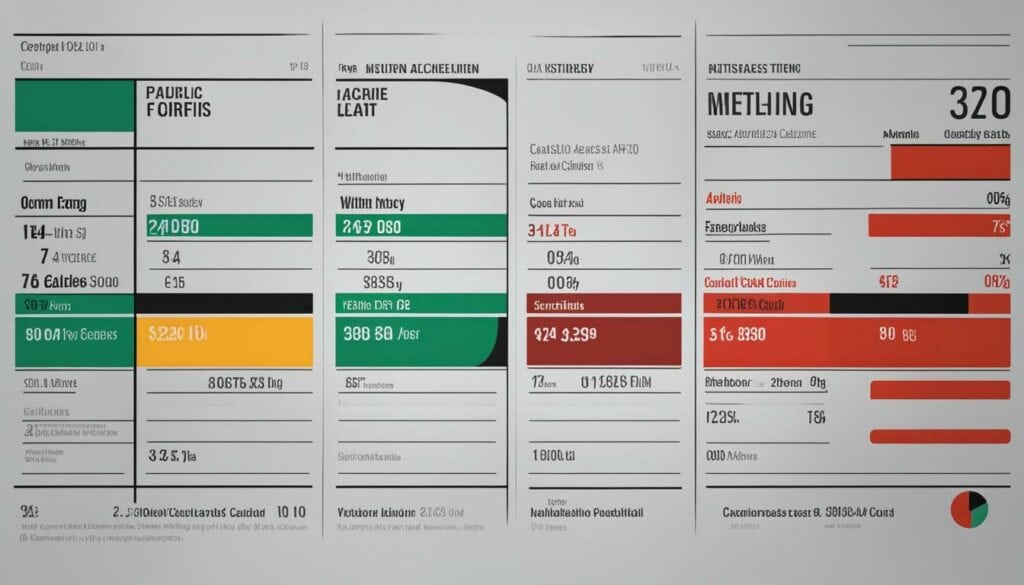 In summary, interpreting the total calorie content on a nutrition label enables you to understand the energy value of a food item. Use this information as a tool to manage your calorie intake and make informed choices that align with your dietary needs and goals. Combining this knowledge with an understanding of nutrient density will help you create a balanced diet that meets your nutritional requirements. Remember, staying mindful of your overall calorie consumption can contribute to maintaining a healthy lifestyle.
In summary, interpreting the total calorie content on a nutrition label enables you to understand the energy value of a food item. Use this information as a tool to manage your calorie intake and make informed choices that align with your dietary needs and goals. Combining this knowledge with an understanding of nutrient density will help you create a balanced diet that meets your nutritional requirements. Remember, staying mindful of your overall calorie consumption can contribute to maintaining a healthy lifestyle.
The percent daily values (DV) listed on nutrition labels can serve as a useful guide in determining the nutritional significance of a food item within the context of your overall diet. These values are based on a 2,000-calorie daily diet, which may vary depending on your individual needs and goals.
| Nutrient | % Daily Value (DV) |
|---|---|
| Total Fat | Less than 65g |
| Saturated Fat | Less than 20g |
| Cholesterol | Less than 300mg |
| Sodium | Less than 2,400mg |
| Total Carbohydrate | 300g |
| Dietary Fiber | 25g |
| Protein | 50g |
These values help you determine if a particular food contributes a high or low amount of a specific nutrient to your daily diet. For example, if a food item has 10% DV of saturated fat, it means that consuming it will contribute to 10% of your daily limit for saturated fat intake.
Using Percent Daily Values (DV)
When navigating the nutrition label, you can use the percent daily values to make more informed choices about the foods you consume. If a nutrient is listed as 5% or less, it is considered low, while 20% or more is considered high.
It’s important to note that individual needs may vary, especially for individuals with specific health conditions or dietary restrictions. Consulting a registered dietitian or healthcare professional can provide personalized guidance on interpreting and applying percent daily values to your diet.
By paying attention to the percent daily values, you can become more aware of the nutritional content of the foods you consume and make choices that align with your health goals. However, it’s important to remember that the percent daily values are just one tool in the larger context of a balanced and varied diet.
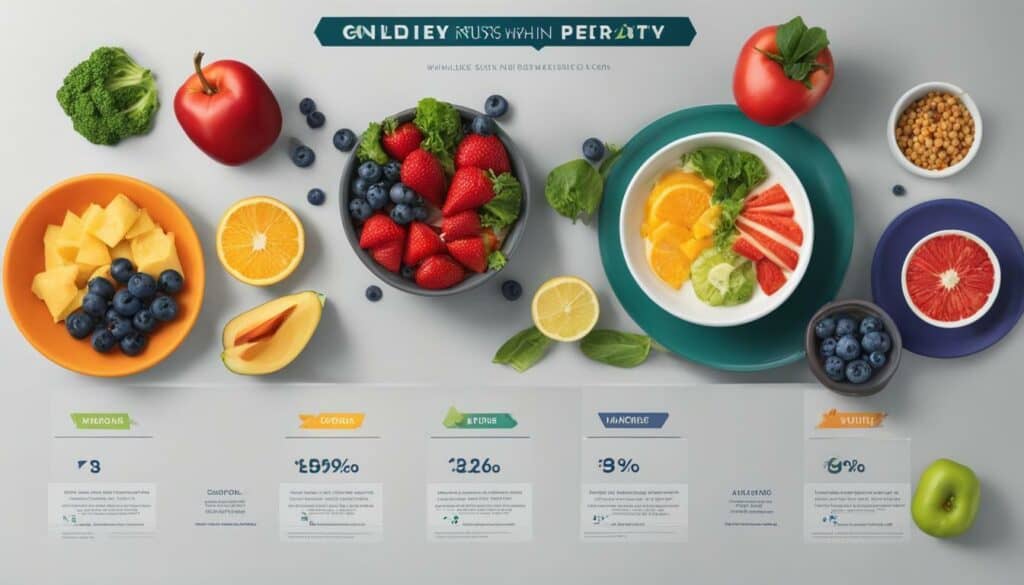
To maintain a healthy lifestyle, it is crucial to limit your intake of certain nutrients, including saturated fat, trans fat, cholesterol, and sodium. These nutrients, when consumed in excess, can increase your risk of developing chronic diseases such as heart disease and hypertension.
When reading nutrition labels, pay close attention to the percentages of these nutrients. Aim for lower percentages to keep your intake within recommended limits. The American Heart Association suggests limiting saturated fat to less than 10% of your daily calories and cholesterol to less than 300 milligrams per day.
Reducing your intake of sodium is also important. The Dietary Guidelines for Americans recommend consuming no more than 2,300 milligrams of sodium per day, or even less if you have high blood pressure or are at risk of developing it. High sodium intake can contribute to high blood pressure, a leading cause of heart disease.
The significance of limiting these nutrients:
- Saturated fat: Found in fatty cuts of meat, full-fat dairy products, and tropical oils, saturated fat can raise your blood cholesterol levels and increase your risk of heart disease.
- Trans fat: Mostly found in highly processed foods, trans fats are artificial fats that can raise your LDL (bad) cholesterol levels and lower your HDL (good) cholesterol levels, increasing the risk of heart disease.
- Cholesterol: While our bodies need cholesterol for various functions, excessive intake of dietary cholesterol can raise blood cholesterol levels and increase the risk of heart disease.
- Sodium: Sodium is commonly found in processed foods, canned goods, and restaurant meals. Consuming too much sodium can lead to high blood pressure and increase the risk of heart disease and stroke.
By being mindful of these nutrients and their impact on your health, you can make informed choices when selecting foods and maintain a balanced diet that supports your overall well-being.
| Nutrient | Daily Limit |
|---|---|
| Saturated Fat | Less than 10% of daily calories |
| Trans Fat | Avoid as much as possible |
| Cholesterol | Less than 300 milligrams per day |
| Sodium | Less than 2,300 milligrams per day (or less if at risk of high blood pressure) |
“Choosing foods low in saturated fat, trans fat, cholesterol, and sodium can contribute to a heart-healthy diet and reduce the risk of developing chronic diseases.” – American Heart Association

Boosting your intake of vitamins, minerals, and dietary fiber can help support overall health and well-being. These essential nutrients play a crucial role in maintaining various bodily functions, from promoting a strong immune system to aiding digestion and preventing chronic diseases.
When reading the nutrition label, look for foods that are rich in these beneficial nutrients. Fruits and vegetables are excellent sources of vitamins and minerals, providing a wide range of essential nutrients necessary for optimal health. Incorporating a variety of colorful produce into your meals can help ensure you’re getting a diverse array of nutrients.
“Let food be thy medicine and medicine be thy food.” – Hippocrates
In addition to fruits and vegetables, whole grains are another important source of dietary fiber, vitamins, and minerals. Fiber is essential for maintaining a healthy digestive system and can help lower the risk of heart disease, diabetes, and certain types of cancer.
Here is a table outlining some key nutrients and their sources:
| Nutrient | Food Sources |
|---|---|
| Vitamin C | Citrus fruits, berries, broccoli |
| Vitamin D | Fatty fish, fortified dairy products, sunlight exposure |
| Calcium | Dairy products, leafy greens, fortified plant-based milks |
| Potassium | Bananas, sweet potatoes, avocado |
| Dietary Fiber | Whole grains, legumes, fruits, vegetables |
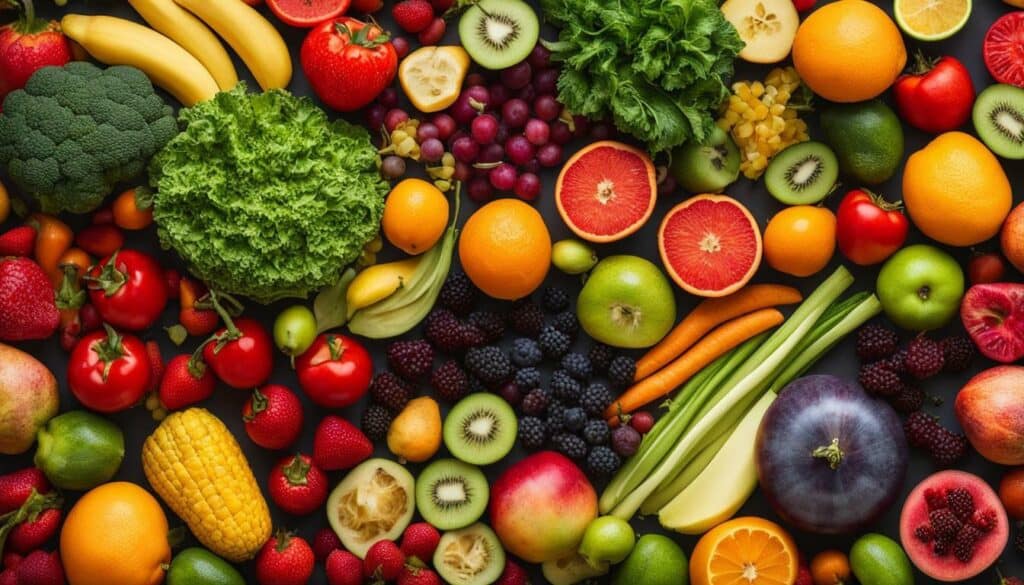
Incorporating these nutrient-rich foods into your diet can have a significant impact on your overall health. Remember to consider both the quantity and quality of the nutrients when making food choices. By prioritizing foods that are high in vitamins, minerals, and dietary fiber, you can optimize your nutrition and enhance your well-being.
Decoding Label Terms
The nutrition label contains various terms that convey information about a food item’s nutritional value, and understanding these terms is key to making healthier food choices. Here are some common terms you may come across:
Low Calorie:
This term indicates that the food item is relatively low in calories. It can be useful if you are watching your calorie intake or trying to lose weight.
Low Cholesterol:
Foods labeled as low cholesterol contain a small amount of cholesterol, which is beneficial for individuals who need to manage their cholesterol levels.
Reduced:
This term means that the food item has less of a specific nutrient compared to its regular version. For example, reduced-fat milk contains less fat than whole milk.
Good Source of:
This term indicates that the food item provides a significant amount of a specific nutrient. For example, a food labeled as a good source of fiber contains a notable amount of fiber.
Excellent Source of:
This term signifies that the food item is an exceptional source of a particular nutrient. It means that the food contains a high percentage of the recommended daily value for that nutrient.
Calorie Free:
Foods labeled as calorie-free contain an extremely small number of calories, typically less than 5 calories per serving.
Fat Free/Sugar Free:
If a food item is labeled as fat-free or sugar-free, it means that it contains an insignificant amount of fat or sugar, respectively.
Low Sodium:
This term indicates that the food item is relatively low in sodium. It can be helpful for individuals who need to monitor their sodium intake, especially those with high blood pressure.
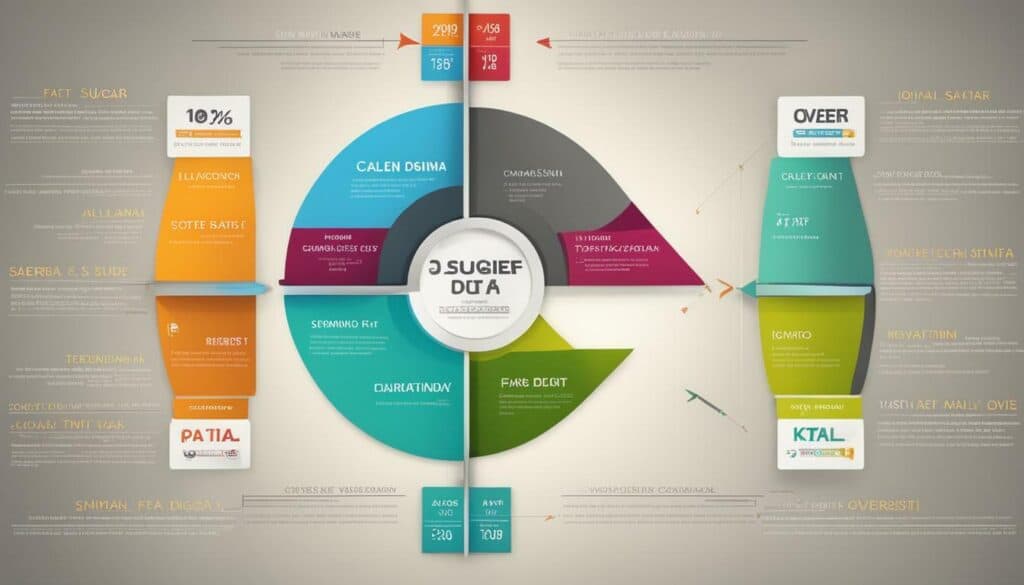
Understanding these terms can help you make informed choices when it comes to selecting foods. However, it is important to note that the terms “low,” “reduced,” and “free” are defined in relation to specific nutrient content and may not necessarily mean the food item is entirely healthy. Always read the complete nutrition label to get a comprehensive understanding of a food item’s nutritional value.
The Significance of Key Nutrients
Certain nutrients play a vital role in maintaining optimal health and well-being, and it is essential to be mindful of their presence and quantity in the foods we consume. When reading nutrition information labels, paying attention to these key nutrients can help us make more informed choices. Let’s take a closer look at some of them.
1. Saturated Fat
Saturated fat has long been associated with an increased risk of heart disease. It is advisable to limit our intake of foods high in saturated fat, such as butter, fatty meats, and full-fat dairy products. Choosing lean sources of protein and low-fat or fat-free dairy options can help reduce saturated fat consumption.
2. Added Sugars
Excessive consumption of added sugars can contribute to weight gain, obesity, and an increased risk of chronic diseases such as diabetes and heart disease. It is important to be mindful of the total sugar content in foods and beverages, including hidden sugars in processed foods. Opting for whole fruits or foods with no added sugars while reducing sugary drinks and desserts is a healthier choice.
3. Sodium
Consuming excess sodium can lead to high blood pressure and increase the risk of heart disease. It is advisable to limit our intake of sodium by choosing lower-sodium options and reducing the use of salt in cooking and at the table. Paying attention to the sodium content in processed foods, such as canned soups and sauces, is also important.
| Nutrient | Recommended Daily Intake | Food Sources |
|---|---|---|
| Potassium | 4700 mg | Bananas, oranges, spinach, potatoes |
| Vitamin D | 600 IU | Fatty fish, fortified dairy products, sunlight |
| Calcium | 1000 mg | Milk, yogurt, cheese, leafy greens |
| Iron | 18 mg | Red meat, poultry, beans, fortified grains |
On the other hand, there are key nutrients that we should aim to increase in our diet. These include:
- Dietary Fiber: Found in fruits, vegetables, whole grains, and legumes, dietary fiber aids digestion and helps maintain a healthy weight.
- Potassium: Essential for proper heart and muscle function, potassium can be found in bananas, oranges, spinach, and potatoes.
- Vitamin D: Required for the absorption of calcium and for healthy bones, vitamin D can be obtained through exposure to sunlight, as well as from fatty fish and fortified dairy products.
- Calcium: Important for strong bones and teeth, calcium is found in milk, yogurt, cheese, and leafy greens.
- Iron: Necessary for the production of healthy red blood cells, iron can be obtained from sources such as red meat, poultry, beans, and fortified grains.
By understanding the significance of these key nutrients and incorporating them into our diet, we can promote overall health and well-being. Let’s make informed choices and nourish our bodies with the nutrients they need.
Protein and Carbohydrates
While not always highlighted on the nutrition label, protein and carbohydrates are essential macronutrients that contribute to a balanced diet. Protein plays a crucial role in building and repairing tissues, supporting immune function, and producing enzymes and hormones. Carbohydrates, on the other hand, provide the body with energy and are the primary fuel source for the brain and muscles.
When analyzing nutrition data, it’s important to consider both the quantity and quality of protein and carbohydrates in a food product. The label may provide information on the total grams of protein and carbohydrates, but it’s also beneficial to evaluate the source of these macronutrients.
Some sources of protein include lean meats, poultry, fish, dairy products, eggs, legumes, and nuts. These are considered complete proteins as they contain all the essential amino acids our bodies need. In contrast, incomplete proteins, such as grains, beans, and vegetables, may lack some amino acids but can be combined with other foods to form a complete protein.
The Significance of Key Nutrients
“Protein is a vital component of a healthy diet as it aids in muscle repair and growth. Carbohydrates, particularly complex carbohydrates like whole grains and fruits, provide sustained energy throughout the day.” – Registered Dietitian, Jane Doe
Carbohydrates can be classified as simple or complex. Simple carbohydrates, found in foods like sugar, candy, and processed snacks, are digested quickly and provide a rapid energy boost. However, they lack essential nutrients and are often high in added sugars. Complex carbohydrates, on the other hand, are found in foods like whole grains, fruits, vegetables, and legumes. These provide a steady release of energy and are rich in fiber, vitamins, and minerals.
By understanding the role of protein and carbohydrates in our diet, we can make informed choices when reading nutrition labels. Incorporating a variety of lean protein sources and opting for complex carbohydrates can help us achieve a balanced nutrient intake and support overall health.
| Protein Sources | Carbohydrate Sources |
|---|---|
| Lean meats | Whole grains |
| Poultry | Fruits |
| Fish | Vegetables |
| Dairy products | Legumes |
| Eggs | |
| Legumes | |
| Nuts |
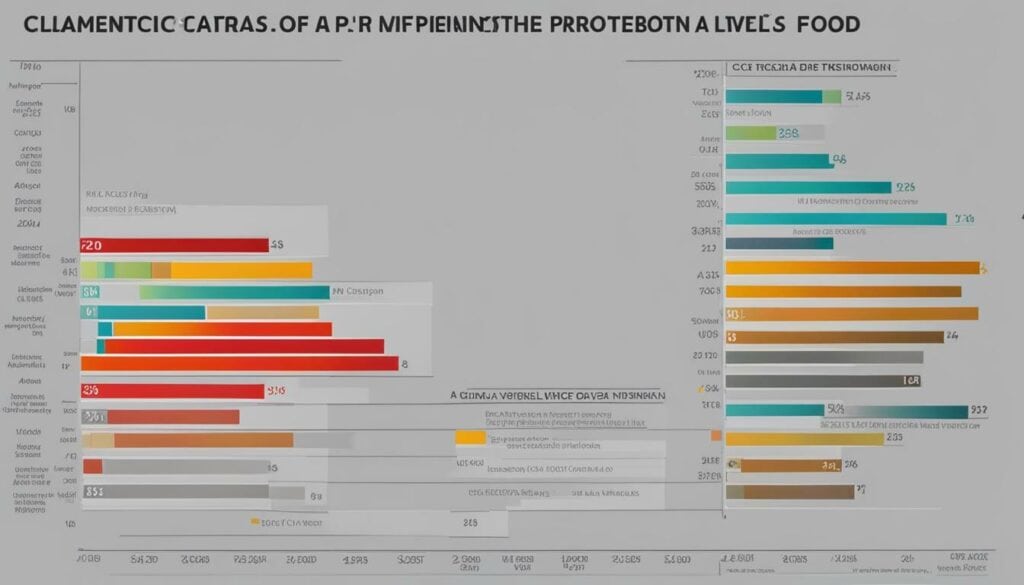
For those with dietary restrictions or specific nutritional needs, examining additional nutrients and the ingredient list is crucial when selecting food products. Beyond the basic nutrition facts, there are often other essential nutrients listed on the label that can provide valuable information about the product’s health benefits or potential drawbacks.
When it comes to additional nutrients, it’s important to focus on what your body needs and what you’re trying to avoid. For example, if you’re looking to increase your intake of vitamin C, you can check for the presence of this nutrient on the label and choose products that offer a higher percentage of the recommended daily value. Similarly, if you have a gluten intolerance, you’ll want to carefully analyze the ingredient list to avoid any potential allergens.
The ingredient list can reveal a lot about the quality and composition of a food product. By scanning the list, you can identify any potential allergens, additives, or preservatives that you may want to avoid. Look for products that have simple, recognizable ingredients and avoid those with a long list of artificial additives. Remember, the ingredient list is listed in descending order by weight, so the first few ingredients carry the most significant impact on the product’s overall composition.
Table 1: Key Additional Nutrients to Consider
| Additional Nutrient | Potential Benefits | Sources |
|---|---|---|
| Omega-3 Fatty Acids | Support brain health and reduce inflammation | Fatty fish, flaxseeds, walnuts |
| Probiotics | Promote a healthy gut microbiome and aid digestion | Yogurt, kefir, sauerkraut |
| Antioxidants | Protect cells from damage caused by free radicals | Berries, dark chocolate, spinach |
| Fiber | Aid digestion and promote feelings of fullness | Whole grains, beans, fruits, vegetables |
Remember, individual nutritional needs may vary, so it’s essential to consult with a healthcare professional or registered dietitian to determine the specific nutrients you should focus on or limit in your diet.

By carefully examining the additional nutrients and ingredient list, you can make informed decisions about the food products you consume. This knowledge empowers you to choose products that align with your dietary needs and preferences. Whether you’re striving for a gluten-free diet, seeking out additional vitamins and minerals, or avoiding specific allergens, taking the time to read and understand these labels can lead to a healthier and more mindful approach to eating.
Putting It All Together
By mastering the art of reading and decoding nutrition information labels, you can take control of your food choices, leading to a healthier and more mindful approach to eating. Understanding the various components of the label can empower you to make informed decisions about what you consume.
Start by familiarizing yourself with the serving size and number of servings. This information allows you to accurately calculate the nutritional values based on your portion size. Next, pay attention to the total calories and compare them to your individual needs. The percent daily values (DV) can serve as a guide in evaluating how a particular food fits into your daily meal plan. Look for low percentages of saturated fat, trans fat, cholesterol, and sodium, while aiming for higher percentages of vitamins, minerals, and dietary fiber.
The label also includes terms such as “low calorie,” “low cholesterol,” and “good source of.” Deciphering these terms will help you make healthier choices. Remember to reduce your intake of saturated fat, added sugars, and sodium, as they can increase the risk of chronic diseases. Instead, focus on consuming more dietary fiber, potassium, vitamin D, calcium, and iron. These nutrients can be found in abundance in fruits, vegetables, and whole grains.
Finally, remember to check the additional nutrients listed on the label and review the ingredient list. This step is especially crucial if you have food sensitivities, allergies, or specific dietary preferences. Being aware of what you are consuming will allow you to make choices that align with your health goals.

- Check serving size and number of servings.
- Compare total calories to your needs.
- Use percent daily values (DV) as a guide.
- Aim for low percentages of saturated fat, trans fat, cholesterol, and sodium.
- Focus on higher percentages of vitamins, minerals, and dietary fiber.
- Understand label terms like “low calorie” and “good source of.”
- Reduce intake of saturated fat, added sugars, and sodium.
- Increase consumption of dietary fiber, potassium, vitamin D, calcium, and iron.
- Moderate lean protein and choose whole grains, fruits, and vegetables.
- Check additional nutrients and ingredient list for specific needs.
By following these tips and utilizing the information provided on nutrition labels, you can make informed decisions about your food choices and embrace a healthier lifestyle.
Conclusion
By embracing the knowledge and skills needed to read and understand nutrition information labels, you can make confident and informed decisions that will positively impact your overall well-being. Understanding how to decode food labels is essential for making healthier choices and ensuring you are meeting your individual dietary needs.
When reading the nutrition information label, start by checking the serving size and number of servings to accurately calculate the nutritional values. Compare the total calories listed to your individual requirements, and use the percent daily values (DV) as a guide to evaluate how the food fits into your daily meal plan.
Pay attention to nutrients to limit, such as saturated fat, trans fat, cholesterol, and sodium. Aim for lower percentages of these nutrients to reduce the risk of chronic diseases. Additionally, focus on increasing your intake of vitamins, minerals, and dietary fiber, which can be found in fruits, vegetables, and whole-grain products.
Finally, don’t forget to review the additional nutrients listed on the label and the ingredient list. This is particularly important if you have food sensitivities, allergies, or specific dietary preferences. By utilizing the information provided on nutrition labels, you can make informed food decisions and choose a healthy diet that supports your overall well-being.
FAQ
Q: How do I read a nutrition information label effectively?
A: Start by checking the serving size and number of servings in the package. Compare your portion size to the serving size to ensure you are calculating the correct nutritional values.
Q: How can I evaluate if a food fits into my daily meal plan?
A: Compare the total calories listed on the label to your individual needs. The percent daily values (DV) can also guide you in evaluating how the food fits into your daily meal plan.
Q: What should I aim for in terms of nutrients to limit and increase?
A: Aim for low percentages of saturated fat, trans fat, cholesterol, and sodium. Aim high in vitamins, minerals, and dietary fiber.
Q: What terms should I understand on the label?
A: It’s important to understand terms such as “low calorie,” “low cholesterol,” “reduced,” “good source of,” “excellent source of,” “calorie free,” “fat free/sugar free,” and “low sodium.”
Q: Which nutrients should I consume more of?
A: Consume more dietary fiber, potassium, vitamin D, calcium, and iron. Fruits and vegetables are excellent sources of these nutrients.
Q: Are protein and carbohydrates important to consider?
A: Yes, it is essential to moderate lean sources of protein and consume whole-grain products, fruits, and vegetables.
Q: What should I check on the label if I have specific dietary preferences or allergies?
A: Check the additional nutrients listed on the label and review the ingredient list. This is especially important if you have food sensitivities, allergies, or specific dietary preferences.
Q: How can reading nutrition labels help me make informed food decisions?
A: By understanding and utilizing the nutrition facts label, you can make informed food decisions and choose a healthy diet that aligns with your individual needs and goals.
What is the Difference Between Working Out Nutritional Information and Reading the Nutrition Information Label?
When trying to make healthier choices, it’s essential to work out nutritional information. This involves calculating the content of fats, carbohydrates, and proteins in a particular portion of food. On the other hand, reading the nutrition information label simply involves checking the pre-calculated quantities of these nutrients provided on the packaging.


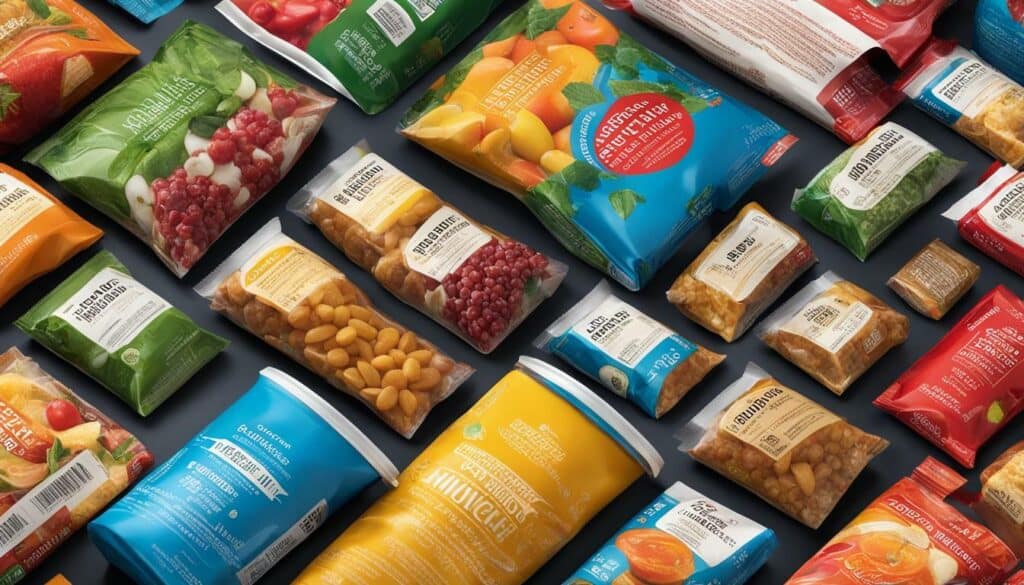



Leave a Reply